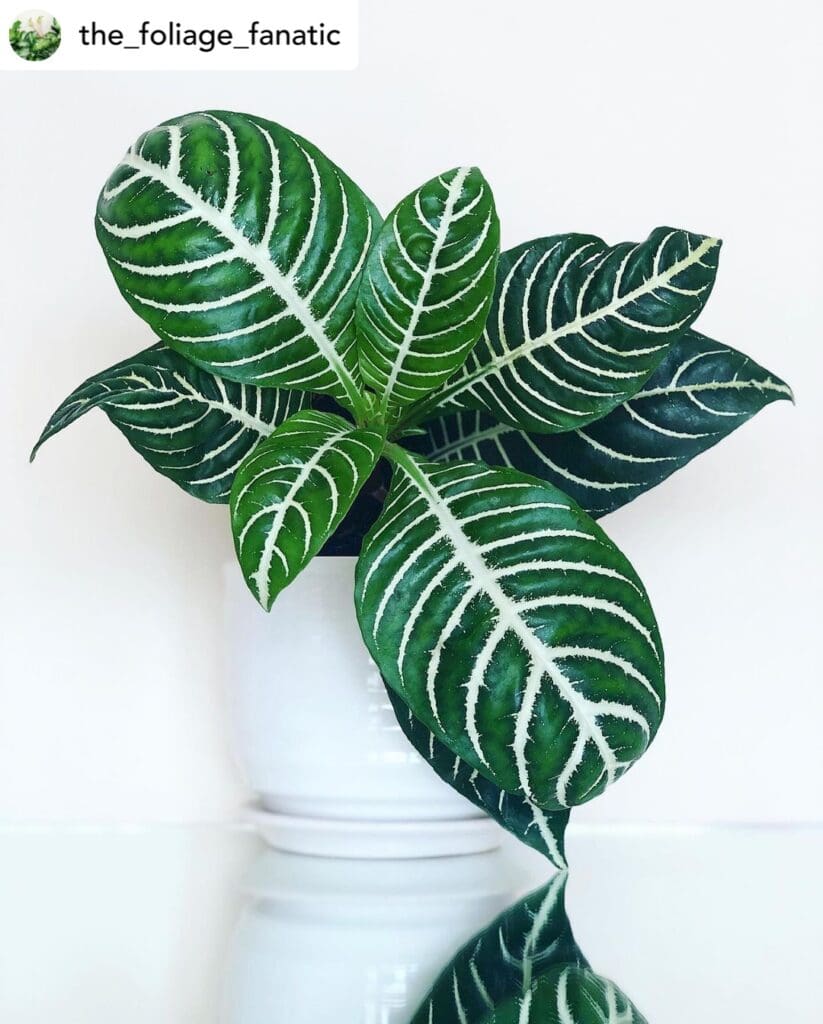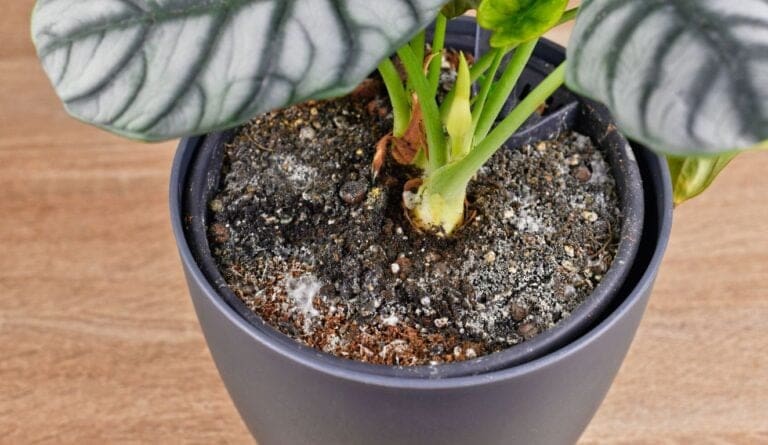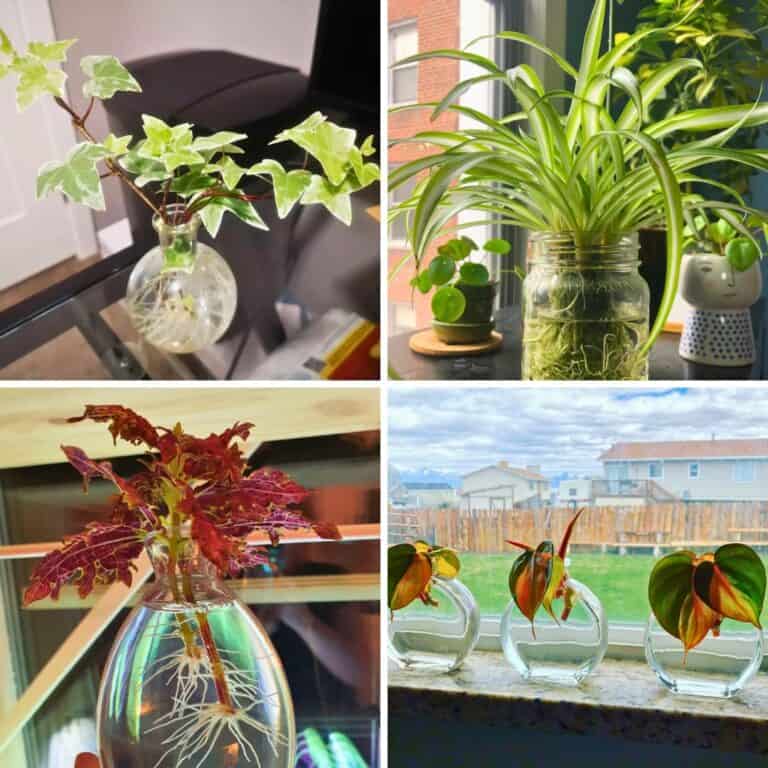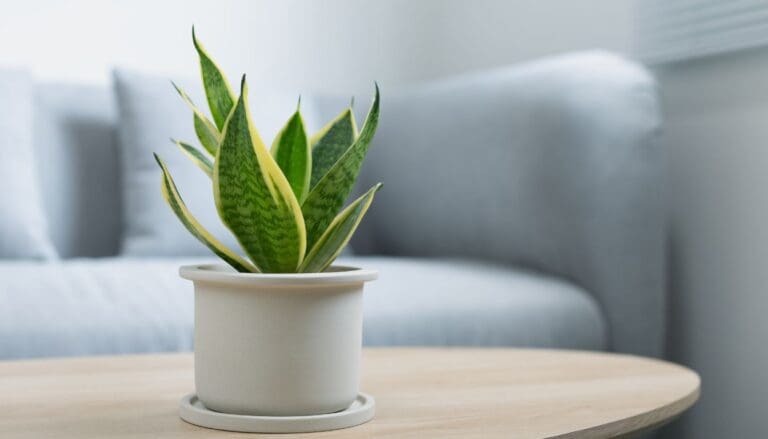Zebra Plant Care Guide: Tips for Thriving Foliage
Looking to add a touch of the wild to your indoor jungle? The zebra plant, with its striking dark green leaves and bright white veins, is a showstopper in any room.
Caring for a zebra plant means finding the perfect spot with bright, indirect light and keeping the soil consistently moist but not soggy. 🌿
I always keep an eye on the humidity around my zebra plant, aiming for around 60-70%. This plant thrives in high humidity, so if your home is a bit dry, consider using a humidifier or placing the pot on a tray filled with water and pebbles. 😌
Ever struggled with keeping houseplants healthy? You’re not alone! Share your favorite plant care tips or ask questions in the comments. 🌱 Let’s grow together!

Please note: Simplify Plants is reader-supported. As an Amazon Associate, I earn from qualifying purchases made by our readers with no extra cost added to you all! Some links in the post are affiliate links and I get a commission from purchases made through links in the post.
Zebra Plant Overview
Ever heard of the Zebra Plant? It’s one of my all-time favorites!
This tropical houseplant has dark green leaves with bright white veins. Just like zebra stripes, right? 🦓
I keep my Zebra Plant in a spot with bright, indirect sunlight. Too much direct light can scorch the leaves. 😅
Do you know what’s fabulous? They thrive in high humidity! So if you find your bathroom windowsill empty, now you know what to put there. 🚿
Speaking of bathrooms, keep the soil moist but not soggy. Water when the top 25% of the soil is dry. It’s like the plant saying, “I’m thirsty, but please don’t drown me!” 😂
Here’s a little table for the ideal conditions:
| Condition | Ideal Range |
|---|---|
| Light | Bright, indirect sunlight |
| Temperature | 60-75ºF (15-23 ºC) |
| Humidity | 60-70% |
| Soil | Well-draining |
Oh, and one more thing. Avoid watering the leaves directly. It can lead to crown rot. Just aim at the soil and you’re golden!
Got a Zebra Plant? Would love to hear your tips or see pictures in the comments! Let’s make our homes greener, together! 💚
Optimal Growing Conditions

To keep your indoor zebra plant thriving, it’s crucial to provide proper light, ideal temperatures, and high humidity. These elements will ensure that your plant stays healthy and vibrant.
Light Requirements
Zebra plants need bright, indirect sunlight to grow their best. Direct sunlight can scorch their leaves, so it’s better to place them near a window with filtered light.
I often use a sheer curtain to protect them from harsh rays.
If you notice the leaves turning brown or yellow, it might be getting too much direct light. On the other hand, if the leaves are dark green and the plant looks leggy, it might not be getting enough light.
Adjust the light accordingly to keep your zebra plant happy.
Temperature Preferences
Maintaining the right temperature is key for zebra plants. They thrive in temperatures between 60-75ºF (15-23ºC).
Extreme temperatures can stress the plant, so avoid placing it near drafts, heaters, or air conditioners.
Think about where you feel comfortable; chances are, your zebra plant will too!
If your home gets chilly at night, make sure the temperature doesn’t drop too low. Consistent warmth helps the plant grow strong and healthy.
Humidity Levels
High humidity is essential for zebra plants. Aim for 60% or higher humidity to mimic their natural tropical environment.
You could use a humidifier or place a tray of water near the plant to boost humidity levels. A simple trick is to group plants together; they create a micro-environment that’s more humid.
Have you ever noticed how plants seem happier in the bathroom? It’s because of the natural humidity!
You can also lightly mist the leaves regularly. Just avoid letting the plant sit in soggy soil, as that can cause root rot.
I hope these tips help you create the perfect environment for your zebra plant! 🌿 Do you have any other indoor gardening tips or tricks? Share them in the comments below! 👇
Planting and Repotting

Caring for a Zebra Plant involves using the right soil and a proper pot, and knowing when and how to repot it. Each step is important for the plant’s health and growth.
Soil Composition
For a healthy Zebra Plant, well-draining soil is a must. I usually go for a mix of potting soil, peat, and perlite. This combination keeps the soil moist yet well-drained.
It’s essential that the soil retains some moisture, but not too much. Zebra Plants don’t like to get their roots all soggy.
Think of it like dipping a sponge in water – it should feel damp but not drenched.
Using a bit of compost can enrich the soil mix further. This adds nutrients and improves the soil structure.
Have you tried mixing in some compost before? I found it really strengthens the plant! 🌿
Pot Selection
Choosing the right pot is more than just picking a pretty one. Zebra Plants like pots that are a bit tight but with room for roots to grow. I look for pots that are only a size larger than the current ones.
Make sure the pot has drainage holes at the bottom. This prevents water from sitting and causing root rot.
Plastic, clay, or ceramic pots – all are fine as long as they provide good drainage.
I’ve noticed decorative pots can sometimes lack drainage. In that case, I double-pot them! Use a plastic pot with holes inside a decorative one.
What pots do you prefer? 🪴
Repotting Steps
Repotting is like a spa day for my Zebra Plant – doing it right is key. Here’s my step-by-step process:
- Prepare: Gather your new pot, soil mix, and a watering can.
- Remove: Carefully take the plant out of its current pot. Gently loosen the root ball.
- Fill: Put fresh soil in the new pot until it covers the bottom.
- Place: Position the plant in the center. Make sure it’s upright.
- Add Soil: Fill in around the roots with soil. Firm it down gently.
- Water: Give it a good drink. Ensure the water drains out the bottom.
Repotting isn’t as tricky as it sounds. Just remember, give your plant a few days to adjust in its new home. Have you tried repotting? Any tips or funny mishaps? Let me know! 🌱👩🌾
Watering Schedule

Keeping your indoor Zebra plant happy involves watering it just right. Here’s a step-by-step guide to make sure your plant stays healthy and thrives.
Watering Frequency
I typically water my Zebra plant every 1-2 weeks. The key is to wait until the top 25% of the soil is dry before you water again.
How do you know when it’s that time? Easy! Just poke your finger into the soil up to your first knuckle. If it feels dry, it’s time to water. 🪴
During warmer months, your plant might need water more often, while in cooler months, less frequent watering is fine.
Consistent moisture is important but avoid overdoing it. Who likes soggy shoes, right? Same goes for plants.
Best Watering Techniques
When it’s time to water, water thoroughly. Pour water at the base of the plant until it starts to drain out of the bottom.
Never leave the plant sitting in water; this can lead to root rot, which isn’t fun for anyone. 🚰
Be sure to empty the saucer if it fills up.
To avoid crown rot, keep water off the leaves as it can funnel down stems and cause problems. Use a watering can with a spout for better control.
Signs of Over-watering
How can you tell if you’re giving your Zebra plant too much water? Look for yellowing leaves and a mushy stem.
These are big hints that your plant is getting too much H2O. 😬
Another tip-off is soggy soil that doesn’t seem to dry out.
It might feel counterintuitive, but sometimes the best thing you can do is let the plant be dry for a bit.
If you see any of these signs, cut back on watering and let the soil dry out more between waterings.
Got your own watering tips or funny watering mishaps? Share them in the comments – I’d love to hear about your experiences! 🌿😊
Fertilization and Nutrition

Keeping your zebra plant well-fed is key to its health and vibrant appearance. I’ll break down the types of fertilizers to use and how often to feed your zebra plant.
Fertilizer Types
I find that using a balanced, all-purpose houseplant fertilizer works best for zebra plants. These fertilizers usually have a 10-10-10 or 20-20-20 nutrient ratio. The labels tell you the percentages of nitrogen, phosphorus, and potassium.
Liquid fertilizers are often the easiest to use. Just follow the instructions on the bottle to mix it with water.
Slow-release fertilizers are also an option if you prefer less frequent feeding. You simply sprinkle a bit into the soil, and it slowly provides nutrients over time.
Do you prefer organic options? Compost tea or fish emulsion can be great for zebra plants too. They might have a stronger smell, but they’re gentle and effective.
Feeding Schedule
During the growing season, from spring to fall, I feed my zebra plants every two weeks. It’s a good rhythm to keep them thriving. Just mix the fertilizer with water and give your zebra plant a good drink.
In the winter, reduce the feeding to once a month. They don’t grow as quickly in the colder months, so they need fewer nutrients.
Too much fertilizer can actually hurt your plant by building up salts in the soil.
Remember, it’s better to under-fertilize than to overdo it. Less is more when it comes to feeding zebra plants.
If you’re unsure, try diluting the fertilizer to half the recommended strength.
Have you ever seen sad, droopy leaves on your plant? 🥺 That might be a sign it needs a little more food!
What’s your favorite type of fertilizer for houseplants? Share your tips in the comments! 🌿✨
Pruning and Maintenance

Pruning and maintaining an indoor Zebra Plant keeps it healthy and looking its best. It involves trimming, cleaning, and regular check-ups.
Pruning Techniques
Pruning keeps your Zebra Plant in shape and promotes healthy growth.
Always cut just above a node or bud to encourage new shoots.
Use sharp, clean scissors or pruning shears for precise cuts.
When cutting larger stems, get close to the main stem without damaging it.
Avoid pruning more than 25% of the plant at once to reduce stress.
Have you tried pruning your plant yet? 🚀
Cleaning the Leaves
Cleaning the leaves is essential.
Using a damp cloth, gently wipe the leaves to remove dust.
This helps the plant breathe better and look shinier.
For stubborn dirt, a mix of water and mild soap can help.
Remember, clean leaves = happy plant! 🌱 Do you clean your plant’s leaves often?
Common Maintenance Tasks
Regular maintenance tasks include watering, fertilizing, and checking for pests.
Water the plant weekly but ensure the soil never gets soggy.
Use a balanced fertilizer every few months for nutrients.
Watch out for pests like spider mites. If you see any, treat them right away. How do you tackle pests on your plants?
Pest and Disease Management

It’s crucial to keep our zebra plants healthy by managing pests and diseases. I’ll guide you through identifying common pests, preventing diseases, and effective treatment methods. Let’s dive in!
Identifying Common Pests
Zebra plants can attract various pests.
Aphids, for example, are often tiny and green or black. They love the undersides of leaves and growing tips.
They suck the sap out of plants, causing stunted growth and sticky residue called honeydew.
Spider mites are another common pest.
These tiny critters leave fine webs, especially in dry conditions. They cause yellowing or speckled leaves, making the plant look unhealthy.
Mealybugs are small and white, and they form clusters on the plant.
They can cause leaves to yellow and drop if not treated.
Disease Prevention
Keeping zebra plants healthy helps prevent diseases.
Start with well-draining soil to avoid root rot. Overwatering is a big no-no.
Maintain moderate temperatures and humid conditions.
I keep my plant in a spot with indirect light and make sure the room has good airflow.
It’s like giving your plant a little spa treatment! 🌿
Remember too much moisture can lead to fungal infections.
Regularly checking for signs of mold or mildew can save your plant.
Treatment Methods
Sometimes, pests or diseases find their way despite our best efforts.
For aphids, I use a gentle spray of soapy water. This helps remove them without harsh chemicals.
Dealing with spider mites? Increase humidity and wipe the leaves with a damp cloth. Neem oil is also effective.
For mealybugs, dabbing them with a cotton swab soaked in rubbing alcohol works wonders.
It sounds odd, but trust me, it’s effective!
For fungal issues, keeping the foliage dry and ensuring good airflow helps.
If root rot occurs, removing the affected roots and repotting the plant in fresh soil can save it.
Propagation Methods
Want to grow your own zebra plant from cuttings? It’s easier than you might think! I’ll walk you through two main methods: stem cutting and leaf cutting propagation. By following these steps, you can expand your plant family in no time. 🌿✨
Stem Cutting Propagation
Stem cutting is a popular method for propagating zebra plants.
Start by selecting a healthy, mature plant with at least three stems.
Using clean scissors or pruning shears, cut a stem that’s about four inches long and has at least two nodes (the points where leaves attach).
Next, prepare your potting mix: a well-draining soil works best.
Place the stem in the soil, ensuring that half of it is buried while the leaf remains above ground.
Water the pot thoroughly to settle the soil and place the pot in a spot with bright, indirect light.
Make sure the soil stays moist but not soggy.
Leaf Cutting Propagation
Leaf cutting propagation is a bit different and often trickier. Although not as common, it can be a fun experiment!
Start by carefully snipping a healthy leaf from the plant. Make sure the leaf is in good condition without any signs of disease.
Place the leaf in a container filled with damp sand or vermiculite.
It’s important that the leaf does not touch the soil to prevent rot.
Keep the container in a warm area with indirect light and maintain high humidity by covering it with plastic or using a humidifier.
Troubleshooting Common Problems
Indoor zebra plants can sometimes face a few issues, but with the right care, they can thrive. I’ll share tips on yellowing leaves, wilting plants, and leaf spotting.
Yellowing Leaves
Yellowing leaves can be frustrating! This usually happens when the plant is getting too much water or too little light.
To fix this, make sure to water the plant only when the top inch of soil is dry. Overwatering can cause root rot, which leads to yellow leaves.
Also, place your zebra plant in a spot where it gets bright, indirect light.
Too much direct sunlight can also cause leaves to turn yellow.
Think of it like giving your plant a nice, cozy spot near a window with filtered light.
Wilting Plant
A wilting plant is often a sign of improper watering or humidity levels.
If your plant looks sad and droopy, check the soil first.
If it’s dry to the touch, it might just need a good drink. Try watering it thoroughly and see if it perks up.
If the soil is moist but your plant still looks droopy, humidity might be the issue.
Zebra plants love high humidity. I recommend placing a humidifier nearby or misting your plant regularly.
You can also put your plant on a tray filled with water and pebbles to increase humidity.
Leaf Spotting
Leaf spots can be caused by both fungal and bacterial infections. It often happens when leaves stay wet for too long.
To avoid this, only water the soil and not the leaves. Make sure there’s good air circulation around your plant.
If you notice spots, remove the affected leaves and clean your tools to prevent spreading. You can also use a fungicide if the problem persists.
Ensure your zebra plant isn’t too crowded; give it some space to breathe.
FAQs
How often should I water my zebra plant?
Water your zebra plant when the top 25% of the soil feels dry.
Make sure to water thoroughly but avoid letting the plant sit in soggy soil. 🌱
What type of light is best for zebra plants?
Zebra plants thrive in bright, indirect sunlight.
Too much direct light can scorch the leaves, while too little light may cause the plant to grow slowly.
What temperature range is ideal for zebra plants?
Keep temperatures between 60-75ºF (15-23 ºC).
Zebra plants do not like sudden temperature changes, so avoid placing them near drafty windows or doors.
Do zebra plants need high humidity?
Yes, zebra plants love humidity! Aim for 60-70% humidity.
If your home is dry, consider using a humidifier or placing a tray of water near the plant.
Can zebra plants be propagated?
Absolutely!
Propagate by snipping a 3-4 inch piece of stem from a healthy plant.
Place the stem in water with at least 1-2 nodes submerged. Change the water weekly. 🌿
Why are my zebra plant’s leaves turning yellow?
Yellow leaves can be a sign of overwatering or poor drainage.
Make sure your pot has drainage holes and that you are not watering too often.
How often should I fertilize my zebra plant?
During the growing season (spring and early summer), fertilize every 7-14 days with a balanced fertilizer.
Don’t forget to lessen or stop fertilizing in the fall and winter.
What should I do if my zebra plant has brown tips?
Brown tips might mean low humidity or inconsistent watering.
Check if your plant is getting enough humidity and stick to a regular watering schedule.
Got more questions? Drop them in the comments! 📝 Let’s keep the conversation going.
Conclusion
Taking care of an indoor zebra plant can be a fun and rewarding experience. With their unique stripes and tropical vibes, they bring a touch of the jungle to your home 🌿.
I’ve learned that zebra plants love bright, indirect light. Make sure to place yours in a spot where it gets just the right amount of sunlight.
Too much direct sunlight can be harsh on their leaves, but too little light won’t let them thrive.
Watering is key! I always water my zebra plant when the top 25% of the soil feels dry.
It’s crucial to avoid soggy soil to prevent root rot.
Humidity is also important. I try to keep it high, around 60-70%. Sometimes, I even mist the leaves for that extra touch.
Temperature matters, too. Zebra plants prefer a range between 60-75ºF (15-24ºC). I keep my home within this range to keep my plant happy.
One thing I found helpful is to regularly check the leaves. If they’re drooping or looking sad, it might be a sign that the plant isn’t getting what it needs. 💦🌞
Do you have any zebra plant care tips or fun stories? Share them in the comments! I love hearing from fellow plant enthusiasts. 🪴✨
Recommended Garden Supplies
| Product Image | Our Recommended Gardening Supplies | Check Offers! |
|---|---|---|
Top Top
Top
Top
Top
Top
Top
Top
Top | rePotme Houseplant and Tropical Classic Potting Soil Mix | Check Offer On Amazon |
 Top
Top
Top
Top
Top
Top
Top
Top | Espoma Organic Indoor Plant Food | Check Offer On Amazon |
 Top
Top
Top
Top
Top
Top
Top
Top | GooingTop LED Grow Light 6000K Full Spectrum Clip Plant Growing Lamp | Check Offer On Amazon |
 Top
Top
Top
Top
Top
Top
Top
Top | Soil Moisture Meter | Check Offer On Amazon |
 Top
Top
Top
Top
Top
Top
Top
Top | Govee Hygrometer Thermometer, Bluetooth Enabled! | Check Offer On Amazon |
 Top
Top | LEVOIT Humidifiers for Large Room(Best For Plants) | Check Offer On Amazon |
 Top
Top
Top
Top
Top
Top
Top
Top | Upgraded DIY Automatic Drip Irrigation Kit, 15 Potted Houseplants Support | Check Offer On Amazon |
 Top
Top
Top
Top
Top
Top
Top
Top | Stainless Steel Heavy Duty Gardening Tool Set | Check Offer On Amazon |
 Top
Top
Top
Top
Top
Top
Top
Top | Bonide Insecticidal Soap | Check Offer On Amazon |
 Top
Top
Top
Top
Top
Top
Top
Top | Bonide 32 oz Spray Neem Oil for Organic Gardening | Check Offer On Amazon |
 Top
Top
Top
Top
Top
Top
Top
Top | Garden Safe Fungicide | Check Offer On Amazon |






